Advanced Shopify Export: Shopify Google Drive Integration
![]()
When it comes to handling import and export in Shopify, options are rather limited. If you need to connect Google Drive with Shopify, for instance, you won’t be able to succeed. And it’s not bad because most merchants still don’t require this integration. Or don’t know that they need it. If you think that Shopify Google Drive integration is something missing, you’ve come to the right place.
Below, you will learn how to use the to connect the two systems. In the following guide, we’ll walk you through two ways of exporting Shopify files to Google Drive. Firstly, you will see the method that involved the built-in export tools. It is time-consuming and cannot be called a fully-features Google Drive Shopify integration. Next, we compare it with the improved procedure that involves our app and helps you save time and effort due to automation and other beneficial features. Since we focus on the export side of the integration, don’t miss our Shopify Google Drive Import guide. More insights are available in our Shopify Cookbook.

Table of contents
Default Shopify Google Drive Export
Shopify’s default export interface primarily allows manual data downloads and doesn’t have a direct built-in feature to export data to Google Drive. However, you can connect Google Drive with Shopify by using the following manual process:
- Export Data from Shopify as you would usually do:
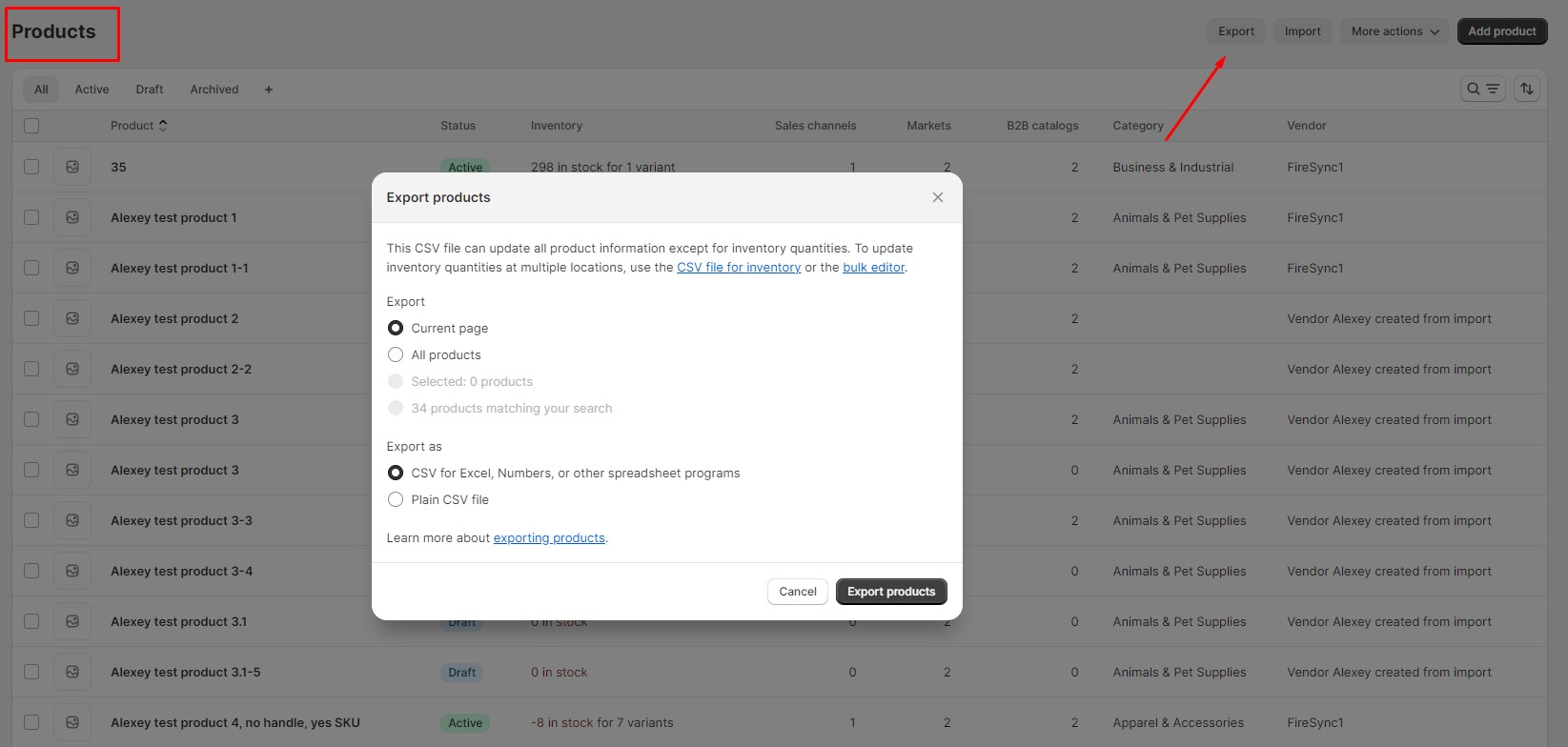
- Log in to your Shopify admin panel.
- Navigate to the section from which you want to export data, such as Products, Customers, or Orders.
- Use the filters and options to specify the data you want to export.
- Click the export button, which typically generates a CSV file.
- Save Data Locally to your computer.
- Upload CSV to Google Drive manually:
- Open your Google Drive account in a web browser.
- Create a new folder if needed to organize your Shopify data.
- Upload the CSV file from your computer to the desired folder.
- Share Data. Once the data is within your Google Drive storage, share it with others if needed.
Please note that this method involves manual steps and may not be the most efficient way to handle data exports from Shopify to Google Drive, especially for large datasets or frequent exports. Luckily, you can automate this procedure. The Improved Import & Export Tool lets you export data from your e-commerce website to the popular file storage.
How to export files from Shopify to Google Drive
Installing the Improved Import & Export Tool is your number one goal when it comes to the Shopify Google Drive integration. Next, prepare a Google Drive folder.
Prepare your Google Drive storage
In Google Drive, create a designated folder for your Shopify exports:
- Navigate to the main page of Google Drive, and on the left side, click “New.”
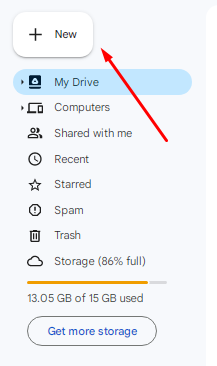
- Select “New Folder” from the options presented.
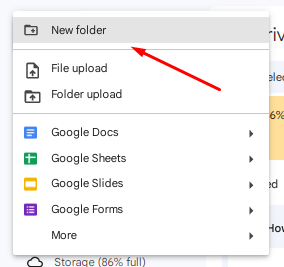
- Name your folder “shopware-import-export” and then click “Create.” You can use only this name since this folder can serve both your Shopify, BigCommerce, and Shopware needs.
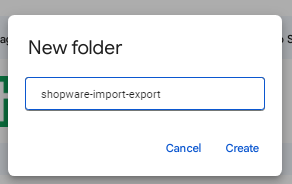
Ensure you share this folder with all the necessary third parties. This collaborative feature makes it convenient for others to access the data whenever required. Now, you’re ready to seamlessly export your updates from Shopify to Google Drive.
Configure a new export profile
To initiate a Shopify Google Drive export using the Improved Import & Export Tool, follow these detailed steps:
1. Create New Export Profile:
You can access your export profiles as follows:

- Go to your Shopify admin panel and navigate to “Apps.”
- Locate the “Firebear Import & Export Tool.”
- Select “Export” and click on the “New Profile” button to configure.
2. Configure Shopify’s connection to Google Drive:
Set up your Shopify Google Drive export profile on the “Select file” screen:
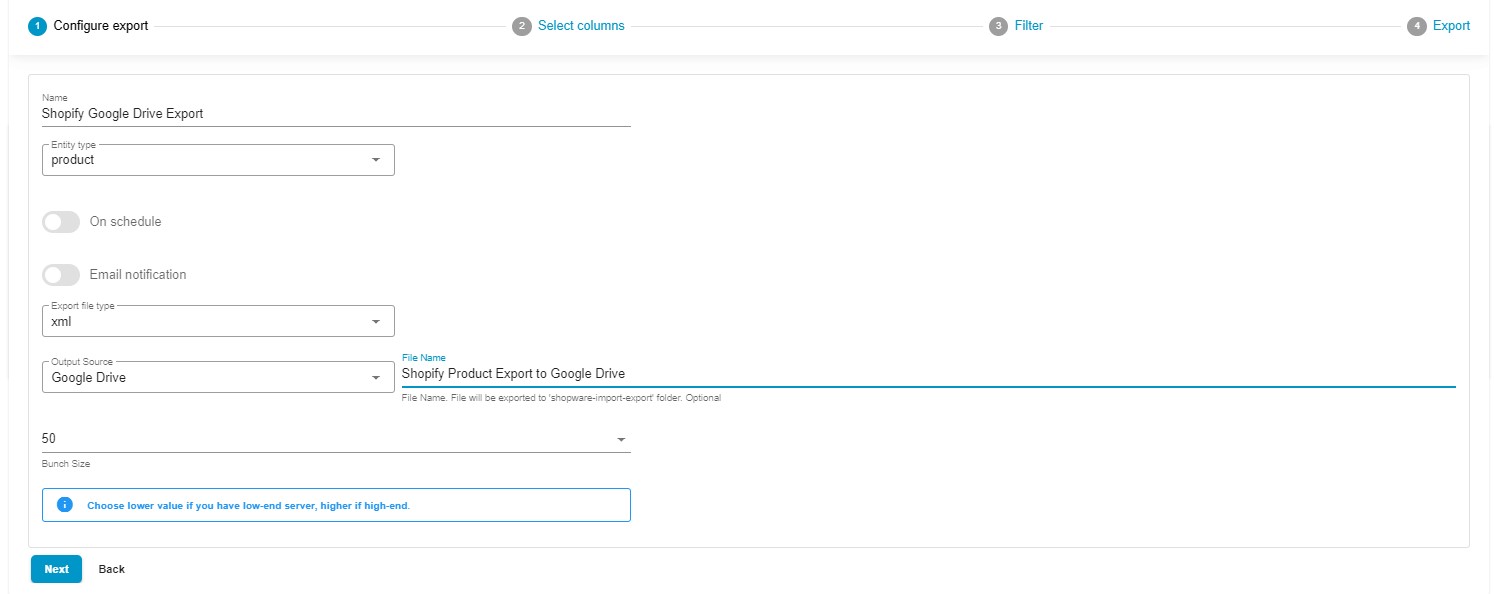
- Specify a name for your profile, e.g., “Shopify Google Drive Export.”
- Choose the entity you wish to export. Choose products if you wish to create Shopify inventory auto-sync with Google Drive. Other supported entities include customers and orders.
- Create a schedule for updates to automate your Shopify Google Drive integration. Choose a time zone, specify the update frequency, and set up the time you want the profile to be launched.
- Configure email notifications if you wish to receive alerts on successful, failed, or both types of exports.
- Select your preferred file format. While the default tools bound you to CSV, our app lets you leverage such formats as XML, XLSX, and Google Sheets spreadsheets.
- Now, you need to choose your file source. Select Google Drive from the dropdown:
– Allow the Improved Import & Export Tool access to your Google Drive storage.
– Specify a unique file name, such as “Shopify Product Export to Google Drive.”
– Note that you can alternatively choose file downloads, FTP transfers, or Google Sheets export. - Adjust the bunch size for your file export, opting for a lower value if your server is on the lower end in terms of performance.
- Click “Continue” to proceed to the mapping screen.
3. Mapping Screen:
Now, you need to configure mappings. You can customize the default Shopify column titles to meet the specific requirements of your partner. Specify new values to replace the defaults.
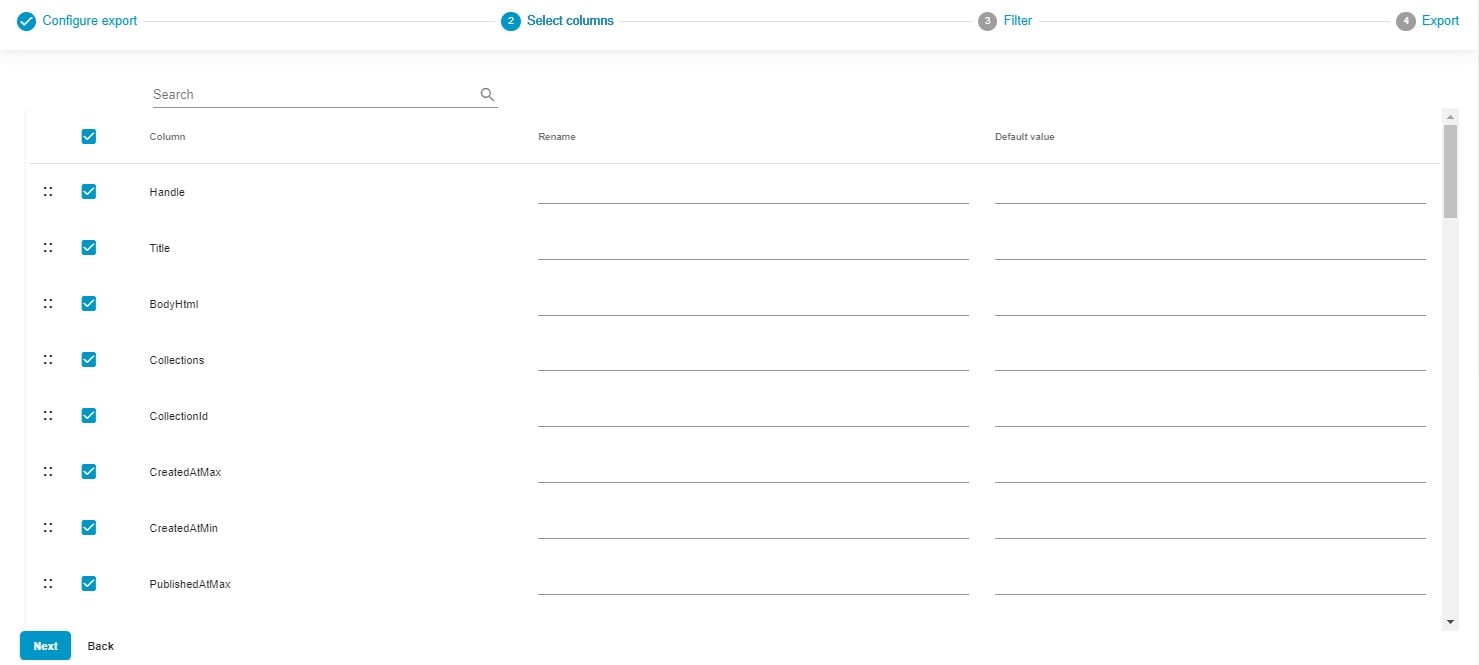
Furthermore, you have the option to deselect any columns you wish to exclude from your Shopify Google Drive integration.
To arrange columns in the desired order, use the drag-and-drop functionality: select the column and drag it to a new place.
At this stage, you can also incorporate default values. If a particular attribute lacks a value, assign a default value within the relevant section. The export file will then seamlessly incorporate the specified default value instead of any absent data.
4. Create Filters:
Proceed to the next section where you can create filters to refine your export selection. For instance, you can filter products with zero stock:

- Add a Filter: Click the “+” button to add a filter to your Shopify Google Drive export profile.
- Select a Product Property: Choose a product property to define the criteria. For instance, you can opt for “Vendor” to filter products based on their producer.
- Specify a Value: Provide the value that aligns with your chosen criteria. Let’s suppose you want to export all items produced by Peavey. Specify the name of this vendor
- Create Multiple Filters: If you need to apply multiple filters to refine your data selection further, simply click the “Add filter” button to add additional filtering criteria.
5. Save and Export:
Click the “Save & Close” button to save your Shopify Google Drive export profile. The app will launch it according to the provided schedule. Alternatively, you can run the profile for the first time after clicking the “Export” button.

After the successful export, you will find your updated data in the “shopware-import-export” folder on the connected Google Drive account.
For more detailed information on the Shopify export capabilities enhanced with the app, refer to the Improved Import & Export Tool manual.
Other Features
The Firebear Import & Export Tool not only addresses the common challenges that often confront Shopify store owners during their import and export endeavors but also elevates these operations through a multitude of ways. As you can see, Shopify Google Drive integration can become a task that is accomplished within a few clicks in comparison to the default data exchange that involves the built-in tools. In stark contrast to conventional methods of data transfer, this application presents a rich selection of features and functionalities carefully crafted to refine and diversify your data management. Here are some of the aspects, already at your disposal or soon to be added:
- Comprehensive Product Import and Export: This tool empowers you to seamlessly import and export products, complete with customizable properties and attributes, affording you the flexibility to tailor your product listings to your unique specifications.
- Effortless Customer Data Import and Export: Simplify the intricacies of managing customer data, as the tool gracefully supports the import and export of customer information, including addresses, providing a holistic perspective on your valued clientele.
- Seamless Order Import & Export: Effortlessly export your order data, granting you valuable insights and enhancing the management of your orders. What’s more, you have the flexibility to import orders from alternative sources, consolidating your sales data under one roof.
- Product Properties Mapping and Convenient Mapping Presets: The tool equips you with the ability to map product properties and employ preset mappings, ensuring that your data harmonizes precisely with the specifications of your Shopify store. The use of presets facilitates the automation of repetitive import processes, streamlining your operational efficiency.
- Scheduled Import and Export Operations: The tool extends scheduling options, enabling the automation of your data transfers at intervals that suit your needs, ultimately saving you valuable time and effort.
- Versatile File Format Support: You can seamlessly collaborate with an array of file formats, including CSV, XLSX, and XLSX, catering to a variety of data sources and formats.
- Effortless Google Sheets Integration: Seamlessly integrate your data with Google Sheets, fostering collaborative and real-time data management.
- Direct File Uploads: Bask in the convenience of direct file uploads, simplifying the data transfer process.
- Secure FTP/FTPS Uploads: Ensure the safety and efficiency of your data transfers with the support for FTP and FTPS uploads, guaranteeing the security and integrity of your data.
- Flexible Google Drive Shopify Integration: Unlock the potential of Google Drive for your data uploads, broadening your data management horizons.
These extensive capabilities grant you precise control over your data, no matter whether you run the Shopify Google Drive integration, connect your store to an ERP system or provide data to a third party for audit. For a deeper dive into the product and its multifaceted features, follow these links:

